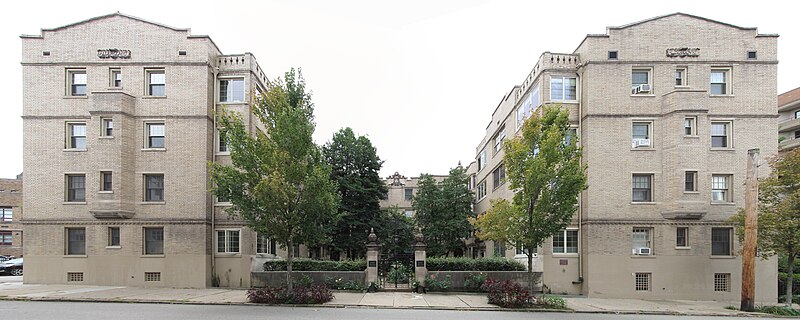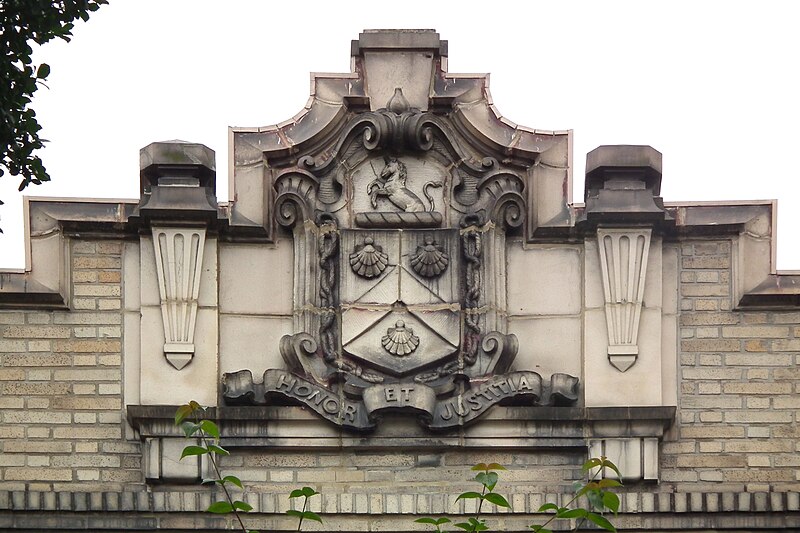
This 1913 Jacobean palace was designed by Henry M. Kropff (his name is misspelled “Kroff” on the Pittsburgh History and Landmarks Foundation plaque on the building), and Father Pitt knows absolutely nothing about the architect. Well, that is not entirely true. We have a few stray facts. An obituary tells us that Henry Moeser Kropff was born in 1876 and died in 1952, and his parents were Ferdinand and Melvina Kropff. The AIA Historical Directory entry for Henry M. Kropff tells us that he died in August of 1952, and he had been a member of the American Institute of Architects since 1916. In his long career, he must have produced something besides Alder Court, but a Google search turns up absolutely nothing else. In fact it took three different search engines to turn up the little information old Pa Pitt has just given you. Yet Google Books tells us that Mr. Kropff was very active in the Pittsburgh Architectural Club in the early twentieth century, designing posters for its exhibitions. (From the Inland Architect for July, 1900: “The Poster of the Exhibition, by Mr. Henry M. Kropff, leaves nothing to be desired. The ‘X’ in ‘Exhibition’ looks better reversed.”)
More trawling in trade magazines may dredge up something interesting eventually. We may suspect that there are numerous apartment buildings and private houses by Henry M. Kropff still standing in Pittsburgh and the surrounding area.
Update: See the very kind comment from Joanne, who used old newspapers to find several other buildings by Kropff. Most are private houses in rich neighborhoods.
At any rate, this is a splendid building, well deserving of its landmark status. It is the “court” part of Alder Court that makes it really pleasant: a beautiful gated garden with shady trees and colorful plantings.
Father Pitt has not been able to identify the coat of arms that presides over the courtyard:

Are these the arms of the original owner? Or just something the architect or his stonecarver made up? Update: See the comment from “von Hindenburg” below, who identifies these as the arms of the Bayard family. The apartments were built on what had been the John B. Bayard estate.

8 responses to “Alder Court, Shadyside”
I absolutely love your website! I searched for Kropff on Newspapers.com and he is given credit for the following (some with his associate James A. Piper):
1911 – home on Solway St, Squirrel Hill, for Dr. Theodore Diller
1912 – fireproof home in Mt Lebanon (no street but photo)
1912 – addition to apartment building, 7040 S Negley Ave, owned by A.G. & B.C. Holmes
1929 – “Treetops” for George R. Hann, Sewickley Heights
1936 – “Winward” for Henry Oliver Rea, Backbone Rd, Sewickley Heights
1951 – described as “retired architect of the David B. Oliver Estate”
Thank you very much for your work. With the help of Pittsburgh Historic Maps, we were able to find Dr. Diller’s house right away, identified on the 1923 layer as belonging to “T. Diller.” Here is an image from Google Maps.
The address 7040 does not exist on South Negley Avenue, but assuming that it was a misprint, we were able to find an apartment building at 704 that did indeed belong to a Holmes, though listed on the 1910 and 1923 maps as William Holmes. Father Pitt has a picture of it. To judge by the outlines on the maps, the 1912 addition was probably a very large endeavor that converted a former single-family house to an apartment building; the front that you see in the picture would thus be Kropff’s work.
[…] information on Henry Kropff, architect of Alder Court. […]
[…] expansion of a single-family house, which was swallowed up in the new construction. Thanks to a commenter, we tentatively identify the apartment building as a design by Henry M. Kropff, built in […]
It appears to be the Bayard Family coat of arms. The representation above left off the ‘Amor’ from the beginning of the motto.
http://www.surnameguide.com/bayard/
That certainly seems to be it. Bayard was an important name in Shadyside and Oakland, and in the Pittsburgh Historic Maps site we find that, before the building went up, this property was part of the John B. Bayard estate.
One imagines the conversation with the architect about the motto. “Honor et justitia, okay,” says the owner, “but no amor in my apartment building.” Or perhaps, after a family squabble, the “AMOR” was stripped from the arms of one branch of the family.
Update: Looking at the page “von Hindenburg” pointed out, we do indeed see that there is a difference in branches of the family. “The above arms, borne by Samuel Bayard 1638 (Holland). The difference in those borne by Petrus Bayard of New York is only in Crest, a demi-unicorn” (because half a unicorn is better than none), “argent; and Motto, Honor et justitia.” If you look at the shadows near the top of the picture above, you will see that the figure is indeed wearing either a stubby horn or a stovepipe hat, so these are the arms of Petrus Bayard.
[…] the Kropf of Kropf & Dickson the Henry M. Kropff who would later design Alder Court in Shadyside? If so, it appears that his name is unspellable in bronze; the Pittsburgh History and […]
Folks that live there say the building is a replica of one in Paris. Wonder if there’s any way to find out?